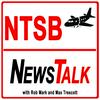21 épisodes

Garmin Autoland Emergency Landing: First King Air Save (Max Heard It Live)
26/12/2025 | 44 min
Episode 20 of NTSB News Talk opens with an aviation milestone: the first confirmed in-service, real-world use of Garmin’s Autoland. A King Air B200, tail number N479BR, squawked 7700 and ultimately landed itself at Rocky Mountain Metropolitan Airport (KBJC) in Broomfield, Colorado on Saturday, December 20, 2025. Garmin later confirmed the activation, and ATC audio captured the synthetic callouts declaring “pilot incapacitation” and the system’s intention to land. Max adds the kind of detail that makes this story feel real: he was flying in Colorado that day, monitoring Guard, and heard the automated messages as they occurred. He also heard a voice transmit on Guard mentioning a depressurization and describing difficulty changing frequencies—consistent with the way Autoland takes control of communications once activated. In their discussion, the flight track shows the airplane climbing out of Aspen into the low-20s, then descending, leveling, and later maneuvering near the destination before landing—exactly the kind of structured “get down, get safe, get on the ground” profile Autoland is designed to execute. Aviation outlets reported the emergency was tied to a pressurization issue and the engagement of emergency descent logic. Aviation International News+1After a quick note that Episode 19 was cited in a New York Post story by Emily Crane, the episode pivots into four NTSB reports that all share one theme: the accidents are “simple” only if you ignore the physics.First is N850JH, a fatal TBM 850 crash near Ludington, Michigan. The NTSB concluded the pilot departed after pulling the airplane from an unheated hangar during active snowfall and taxiing out with visible snow contamination on the wings and horizontal stabilizer. Deice boots don’t solve that on the ground; contamination kills performance margins by reducing lift and increasing drag right when the airplane is most vulnerable—after rotation. The report narrative (and local coverage quoting it) describes a normal-looking departure that quickly turned into a wing drop, stall, and impact. Next is N7756N, a Cherokee accident at Frazier Lake Airport in Hollister, California (Sept. 10, 2025)—no injuries, but packed with lessons. The pilot came in high and fast, tried to salvage it with a slip, floated significantly, then initiated a late go-around. During the go-around attempt, the wheels touched down about two-thirds down the grass runway; with 40° flaps still selected, the airplane became airborne again, but the pilot saw about 45 knots and a mostly-on stall warning and then pulled power to idle to “abort” the go-around, leading to a hard landing, bounce, and impact with a dirt mound. The report also highlights a major contributing setup: landing runway 05 with wind 250 at 11—i.e., meaningful tailwind. Third is a fatal VFR-into-IMC CFIT involving N320P, a Lancair 320 near Manitowoc, Wisconsin. The flight...

Citation 550 Crash in Statesville NC Kills NASCAR Driver Greg Biffle and Family
18/12/2025 | 37 min
Max talks with Rob Mark about the fatal crash of a Citation 550 in Statesville, North Carolina, that killed six people, including a NASCAR driver Greg Biffle and members of his family. The accident occurred shortly after takeoff, making it one of the most closely watched aviation tragedies of the week and a focal point of this episode.Preliminary information indicates the Citation 550 departed Runway 10 at Statesville Airport and soon reported engine trouble. The crew attempted to return to land on Runway 28. ADS-B data shows the aircraft remained airborne for approximately seven minutes and came remarkably close to completing the return. The jet maneuvered back toward the airport, descended unusually low on downwind—likely to remain below cloud ceilings—and successfully aligned with the runway before crashing just short of the pavement following a rapid descent and post-impact fire.Weather conditions at the time were poor but not extreme, with drizzle, reduced visibility, and broken ceilings reported near the time of the accident. Max and Rob discuss how emergency returns immediately after takeoff create one of the highest workload scenarios pilots face, especially when compounded by weather, low altitude, and potential mechanical failures. While twin-engine aircraft are designed to continue flight after an engine problem, this accident highlights how quickly margins disappear when multiple stressors converge.The episode then places the Statesville crash within a broader context of recent fatal accidents involving business jets. Max and Rob examine a Citation III crash in Toluca, Mexico, that killed all ten people on board. Although weather at the time was VFR, the airport’s high elevation—approximately 8,500 feet—dramatically reduced aircraft performance. ADS-B data revealed excessive airspeed on short final, followed by an attempted go-around that showed no sustained climb. The hosts note that go-arounds at high density altitude are particularly unforgiving, and that many pilots underestimate how marginal climb performance can be when aircraft are heavy.Attention then turns to an unusually blunt public statement from NTSB Chair Jennifer Homendy, who criticized proposed military exemptions to ADS-B requirements in Washington, D.C. airspace. Homendy warned that maintaining separate rules for military aircraft risks repeating history, referencing a fatal midair collision nearly a year earlier involving a military helicopter operating without ADS-B. Max and Rob discuss how exceptions intended for rare circumstances can become normalized, undermining the very safety systems designed to prevent collisions.Several additional accidents are reviewed, including a fatal Twin Comanche crash in Illinois and a night training flight in Louisiana that ended when a Cessna 172 crashed into Lake Pontchartrain. In the Louisiana accident, ADS-B data showed a gradual descent toward the airport, followed by a tight 180-degree turn and a sudden acceleration. In the final seconds, the aircraft’s descent rate increased dramatically, consistent with somatogravic illusion—a powerful and often deadly sensory illusion caused by acceleration in dark or instrument conditions.Max explains how somatogravic illusion can trick pilots into believing the aircraft is pitching up when it is not, prompting them to push forward on the controls. In visual conditions, outside references correct the error. At night or in IMC, the...

Air India 787 Crash Investigation: NTSB–India Standoff, Black Box Battle & Stunning Near Misses
01/12/2025 | 44 min
Episode 18 begins with an extraordinary behind-the-scenes dispute surrounding the Air India Boeing 787 crash investigation. Max and Rob open with a Wall Street Journal report describing how U.S. technical experts arrived in Delhi last summer expecting to assist with the black-box analysis, only to be told they would need to board a late-night military flight to a remote facility. NTSB Chair Jennifer Homendy expressed concerns about U.S. personnel and equipment being moved into an area under State Department terrorism advisories, especially given rising tensions in the region. The NTSB pushed instead for data extraction either in Delhi or in Washington, triggering a rapid series of high-level calls involving the U.S. Secretary of Transportation, Boeing, and GE Aerospace.Indian officials insisted they had full capability to download the recorders, yet simultaneously requested more than 30 pieces of specialized equipment from the NTSB, further complicating the diplomatic dynamics. Homendy ultimately issued a 48-hour ultimatum: select Delhi or Washington for the data download, or the U.S. would withdraw from the investigation entirely. India chose Delhi, but the episode highlights how political sensitivities can shape technical investigations—especially when early evidence, as reported, suggested the possibility of intentional fuel-cutoff switch manipulation. The hosts note that pilot-suicide scenarios, though rare, account for more fatal commercial accidents than many pilots realize, citing EgyptAir, Germanwings, Malaysia 370, and other historical cases.From the geopolitical, the episode shifts to more traditional NTSB investigations. A midair collision in Canada between a Cessna 172 and a Piper Seminole resulted in the 172 losing a wing and crashing, while the Seminole landed safely. Max shares the surprising statistic that roughly half of U.S. midair collision victims survive and recounts how a midair experienced by Cirrus co-founder Alan Klapmeier helped inspire the CAPS parachute system.The next story involves a Piper Arrow III that crashed during a nighttime arrival in Pittsfield, Illinois. The pilot had flown nearly five hours from Alabama—an exceptionally long time in that type of aircraft—and arrived as conditions were deteriorating to low visibility and a 300-foot overcast. Max emphasizes the difficulty of recognizing inadvertent IMC at night and discusses how fatigue and lack of instrument proficiency may become factors once more details emerge.A TBM 700 accident in Monroe, Wisconsin offers another sobering look at missed-approach challenges. With visibilities down to a quarter-mile and ceilings around 300 feet, the aircraft attempted a GPS approach to Runway 12, then initiated a missed approach. Instead of climbing outbound on the published track, radar data shows the aircraft turning prematurely, losing airspeed, and entering a stall and loss of control. Max highlights how even experienced instrument pilots often under-practice missed approaches in actual IMC, making it one of the most common fatal accident points in general aviation.The episode then examines a dramatic near-miss involving an Air Arabia Maroc Airbus A320 departing Catania, Italy. A ferry crew failed to load weight-and-balance data into the MCDU, meaning no V-speeds were computed. The aircraft rotated late, climbed shallowly, then descended toward the sea at night, triggering multiple GPWS warnings before the crew recovered at just 41 feet above the water. With moonless, dark-night conditions and no visual horizon, this oversight nearly resulted in a hull loss. Both pilots were highly experienced—proof that skipping basic procedures can endanger even seasoned crews.Next, Max and Rob turn to the UPS MD-11 engine-separation crash in Louisville. New preliminary findings show fatigue cracking in engine-pylon attachment lugs, reminiscent of the American Airlines DC-10 crash in 1979 where a maintenance...

Trim Runaways, CAPS Saves, and Why IFR Pilots Still Lose Control: Lessons from This Week’s NTSB Reports
17/11/2025 | 40 min
Episode 17 of NTSB News Talk brings together an unusually rich set of accidents and safety insights, all centered on pilot decision-making, trim system failures, swept-wing stall risks, and the ongoing challenge of hand-flying in IMC when automation misbehaves. In this week’s discussion, hosts Max Trescott and Rob Mark use recent NTSB reports to highlight the mistakes, mechanical failures, and chain-of-events that continue to trap even experienced pilots. For listeners who fly IFR, rely on autopilots, or operate aircraft with electric pitch trim, this episode offers lessons that are immediately relevant.The episode opens on an encouraging note. Max reports that the United States saw three CAPS parachute deployments in three days—Tuesday, Wednesday, and Thursday. These weren’t all Cirrus aircraft, either; one was N163BR, a Lancair Turbine LX7, one of the fastest experimental turbine singles in the fleet. All three incidents involved engine failures on approach, and every person involved walked away uninjured. For Max and Rob, it’s another sign that whole-airframe parachutes continue to save lives and will become increasingly common as the general aviation fleet modernizes.But the tone shifts as the hosts examine the crash of N30HG, a King Air B100 on a humanitarian mission to Jamaica following Hurricane Melissa. Shortly after takeoff from Florida, the aircraft descended rapidly and struck palm trees before crashing into a pond, killing both on board. A similar King Air pilot’s Facebook account of a pitch trim runaway and violent pitch-down event becomes an important point of comparison. While the NTSB has not yet identified the cause, the parallels highlight how aggressive and unexpected trim-related events can be—and how essential it is for pilots to know exactly where the trim and autopilot disconnects are located, especially when operating older turbine aircraft.In the next case, XA-JMR, a Mexican registered Hawker 800XP fatal accident near Battle Creek, Michigan, post-maintenance work required a swept-wing stall test. The Hawker had been down for seven months while technicians inspected the wing’s leading edges for corrosion. Manufacturer guidance requires that a qualified test pilot perform the post-maintenance stall series. But when the crew was unable to schedule one, they elected to fly the test themselves. Moments after entering the test area at 15,000 feet, the crew transmitted in Spanish that they had stalled the aircraft and were attempting to recover—an attempt that ultimately failed. For Rob, a veteran swept-wing pilot, the lesson is clear: pilots must say “no” when a task exceeds their experience or training, especially in high-AOA testing where swept-wing handling characteristics are unforgiving.The episode then examines several loss-of-control accidents during IFR operations. N9627X, a Cessna 210 bound for Jonesboro, Arkansas deviated around convective weather, then began a series of inexplicable turns and large speed changes before crashing in heavy IMC. A separate Cirrus SR22 accident in Louisiana involved a pilot who reported autopilot issues during a go-around, then lost control while hand-flying. Both accidents reinforce how quickly pilots can become disoriented when hand-flying after automation confusion—especially in turbulence or low visibility.The hosts next highlight a

Fatal Pilot Errors: How Common Medications Led to Deadly Crashes
05/11/2025 | 39 min
Max Trescott and Rob Mark explore one of the most overlooked killers in aviation: common medications that quietly impair pilots and contribute to fatal crashes. While many aviators think over-the-counter or prescription drugs are safe if they “feel fine,” the NTSB’s recent accident reports tell a different story. In case after case, pilots who ignored FAA medication rules—or failed to understand them—lost control of their aircraft, sometimes within seconds of takeoff. Pilots should read the FAA's Over-the-counter (OTC) Medications Reference Guide before taking an OTC medication.The episode opens with a discussion of the NTSB’s recent safety recommendation involving Learjet landing-gear inspections, then pivots to a more personal revelation. While preparing a previous show, Max reviewed several fatal accident reports and realized that three of them, selected at random, shared a common factor: medication use. A fourth involved an untreated medical condition. That chance discovery became the foundation for this episode.The first accident involves N510KC, a Piper Malibu converted to turbine power that crashed shortly after takeoff in Nebraska. Toxicology revealed Ambien (Zolpidem), a powerful sleep aid. The pilot—experienced and well-trained—appeared to rotate normally before the airplane rolled left and hit trees. Rob recalls his own experience with Ambien and how it caused amnesia: “My wife said I was talking and walking before bed, and I had no memory of it.” The NTSB concluded that impairment and overloading likely caused the loss of control.The next accident centers on N915DV, a Cessna Turbo 206 that struck mountainous terrain in Utah. The pilot had taken cetirizine (Zyrtec), an antihistamine many pilots assume is “safe.” Yet studies show that even mild sedation can impair cognitive performance—especially at altitude. The U.S. Navy found that cetirizine increased errors during flight-simulation tests at 10,000 and 15,000 feet. Zyrtec appears on the FAA’s “no-go” list, and pilots must typically wait up to five days after the last dose before flying.In another case, N880A, a Cessna 414 stalled after takeoff when the elevator trim was left in a full-nose-up position. The pilot had taken sertraline (Zoloft), an antidepressant that requires special FAA issuance and strict medical monitoring. He hadn’t reported it on his medical. Investigators also found other red flags: diabetes, unresolved maintenance issues, and a non-functioning tachometer. Rob calls leaving the engines running while stepping out of the aircraft “reckless,” and Max explains how unreported antidepressant use can disqualify a pilot without proper documentation.The final crash involved N4184G, a Nanchang CJ-6A performing a flyover in Colorado. The pilot abruptly pulled into a vertical maneuver, stalled, and spun in. Post-accident analysis revealed uncontrolled diabetes with blood-sugar readings over eight times normal levels. He had previously disclosed diabetes on his FAA medical but failed to list it later—suggesting denial or complacency. Fatigue or blurred vision may have contributed to his erratic control inputs.Across these four crashes, one lesson stands out: pilots often underestimate how...
Plus de podcasts Loisirs
Podcasts tendance de Loisirs
À propos de NTSB News Talk – Aviation Accidents, Safety Investigations & Pilot Lessons
Écoutez NTSB News Talk – Aviation Accidents, Safety Investigations & Pilot Lessons, Red Alert - Actu jeu vidéo ou d'autres podcasts du monde entier - avec l'app de radio.fr

Obtenez l’app radio.fr gratuite
- Ajout de radios et podcasts en favoris
- Diffusion via Wi-Fi ou Bluetooth
- Carplay & Android Auto compatibles
- Et encore plus de fonctionnalités
Obtenez l’app radio.fr gratuite
- Ajout de radios et podcasts en favoris
- Diffusion via Wi-Fi ou Bluetooth
- Carplay & Android Auto compatibles
- Et encore plus de fonctionnalités


NTSB News Talk – Aviation Accidents, Safety Investigations & Pilot Lessons
Téléchargez l’app,
Écoutez.





































